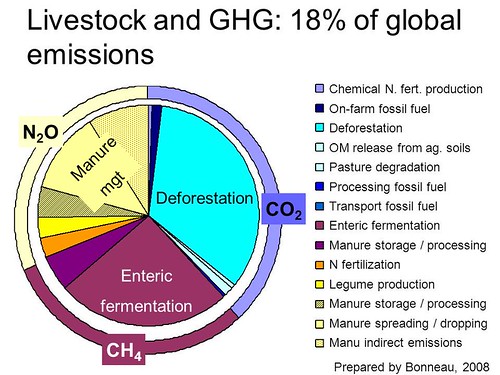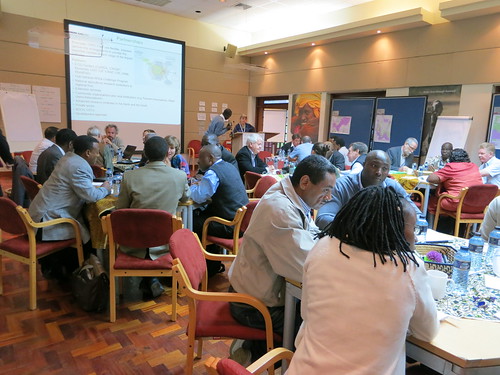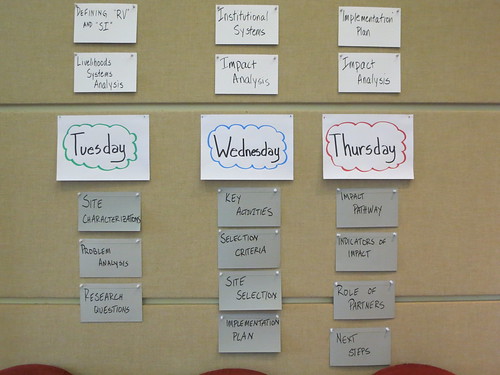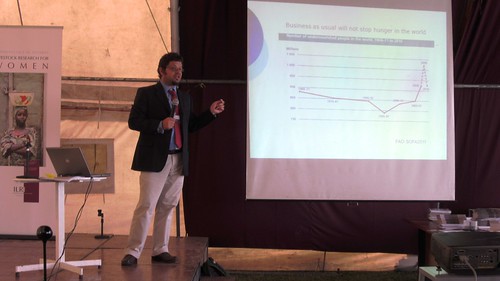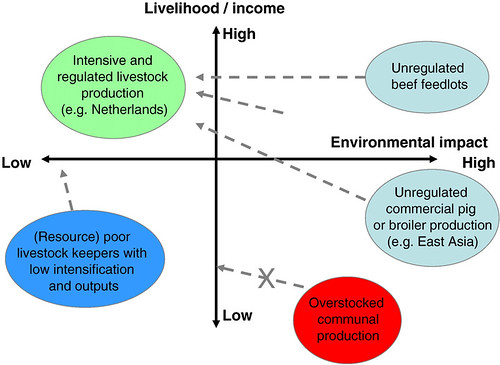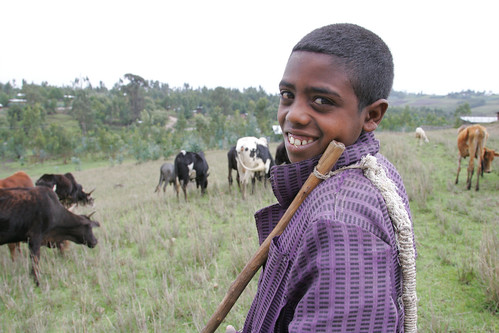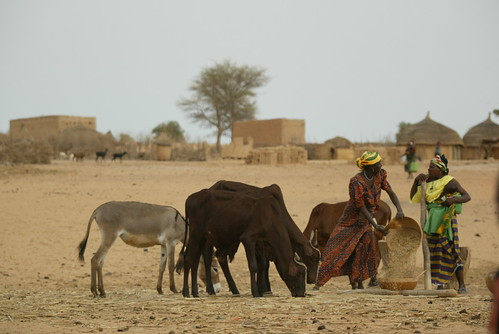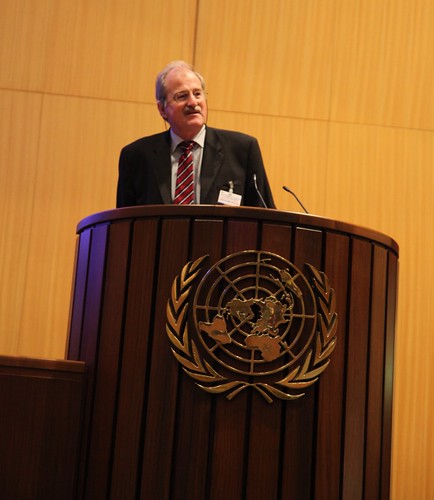
Harrison Rware, an ILRI researcher, listens to Sinayo Taigo, a farmer in Mvomero District, Tanzania during a review of 3-year work plans developed by women in a program that is setting up community-managed breeding programs for dairy goats and introducing improved varieties of cassava and sweet potato in the country (photo credit: ILRI/Deo Gratias Shayo).
Researchers in Tanzania are exploring how small-scale farmers might better integrate production of root and tuber crops, such as cassava and sweet potatoes, with rearing dairy goats to improve the food and nutritional security of their households.
Surprisingly, few programs in Tanzania have yet focused on integrating these crops with small ruminants, such as goats. This is despite the fact that sweet potato and cassava are among the most important root and tuber crops grown by the country’s farmers, most of whom keep goats. Cassava and sweet potato provide human food in periods of hunger, provide feed for ruminant animals (leaf meal from cassava and vines from the sweet potato plant), and can be grown in semi-arid areas.
With farmers, the scientists are setting up community-managed breeding programs for dairy goats and introducing improved varieties of cassava and sweet potato. Both dairy goats and root crops are new to the study region, the Mvomero and Kongwa districts of Morogoro and Dodoma regions, respectively, where project staff distributed Toggenburg and Norwegian improved breeds of dairy goats to 107 farmers in February 2012.
Drought-tolerant varieties of cassava and sweet potato have never before been farmed at large scale in the region and dairy goat keeping has previously been restricted to the wetter areas of the districts. ‘This is changing now,’ says Faustin Lekule, a professor with Sokoine University of Agriculture, ‘because with the use of these crops, we can now introduce dairy goats in dry agro-pastoral areas.’
Led by Tanzania’s Sokoine University of Agriculture and the University of Alberta, in Canada, the project also involves collaboration with the agricultural research institute in Kibaha, the Kongwa and Mvomero district councils and the Foundation for Sustainable Rural Development, a non-governmental organization. The International Livestock Research Institute (ILRI) is serving as knowledge-support partner for the project and is providing expertise on goat production, gender integration, monitoring and evaluation, and assessing food and nutritional security.
‘We’re combining project- and community-based indicators to ensure that farmer decisions guide the project’s implementation,’ said Pamela Pali, a scientist at ILRI who is leading the monitoring and evaluation component of the project. The project is using a web-based monitoring and evaluation system, set up by ILRI’s Research Methods Group, to collect and share information on how farmers are responding to the project’s interventions.
A gender analysis has been applied from the start of the project, including in its research design. ‘We analyzed gender roles, time use, labour allocation and other gender-related factors associated with raising dairy goats and cultivating root crops,’ said Pali. This information was used to refine the distribution of goats and planting materials to households.
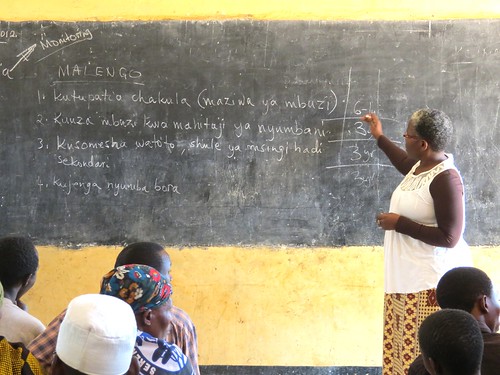
ILRI scientist Pamela Pali leads a session on community-based monitoring and evaluation to train farmers in Kongwa District, Tanzania on creating project objectives and indicators (photo credit: ILRI/Deo Gratias Shayo).
Results from the study sites show that few women own goats or have control over the milk produced and sold from dairy goats. As the demand for milk and milk products increases in cities and milk points, men’s role in milk marketing has taken centre stage. ‘But we also know that livestock activities for women in Africa increase with intensification of production’, says Pali. ‘Seasonal and gender differences in livestock activities such as feeding, watering and milking must be well understood so that we avoid the extra work load on women but ensure that their control over the benefits is increased.’
A key input of the project has been capacity building. Both Sokoine University of Agriculture and the agricultural research institute in Kibaha are training farmers how to raise dairy goats.
‘I received a goat in February this year. As a result of the training, I now understand how to feed the animal, construct a better goat house and identify signs of diseases for my goat. This project has improved my farming skills,’ said Subeida Zaidi, a woman farmer in Kongwa District.
Farmers like Zaidi, who keep goats and grow root crops on small plots typically about one-quarter of an acre, both consume the milk produced by their animals at home and will start to sell it to meet their cash needs. Sustainability is built into this project: once a goat produces offspring, its owner gives a female kid to another farmer, thus ‘passing on the gift’, to use the term made popular by the American non-governmental organization Heifer International.
The project’s monitoring and evaluation trainings have helped farmers clarify their objectives, which include increasing the number of goats they keep, the amount of milk their goats produce and the amount of dual-purpose food-fodder root crops they cultivate. The farmers keep records of their milk production, and this information is supposed to be regularly fed into the web-based monitoring and evaluation system. The researchers are using the information generated to put checks against interventions that are likely to impact women and men, especially those that will narrow the gender, nutrition, income and asset gaps between men and women. The information is also helping project staff and the community members to better understand, and make better use of, the informal markets and ‘value chains’ in the region that the farmers use.
In particular, the University of Alberta is using the project to assess the economic impacts of informal markets, trading and gift giving between households at the village level. Knowing how these informal markets for root crops and goats work will broaden understanding of, and inform, ongoing initiatives in the project.
This project, ‘Integrating Dairy Goats and Root Crops Production for Increasing Food, Nutrition and Income Security of Smallholder Farmers in Tanzania’, is funded by Canada’s International Development Research Centre, and Canadian International Development Agency (CIDA).
Read more about the project http://ilri.org/node/1177 and https://sites.google.com/a/ualberta.ca/diary-goats-and-root-crops-tanzania/home
For more information, read a working paper about this project published earlier this year: Integrating improved goat breeds with new varieties of sweet potatoes and cassava in the agro-pastoral systems in Tanzania: A gendered analysis, by Petra Saghir, Jemimah Njuki, Elizabeth Waithanji, Juliet Kariuki and Anna Sikira, 2012, ILRI Discussion Paper No. 21, International Livestock Research Institute.


